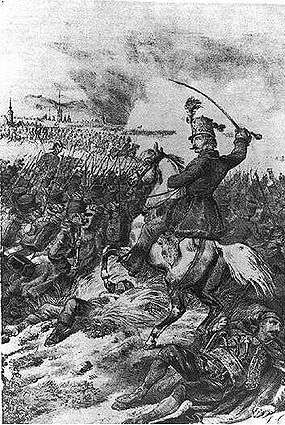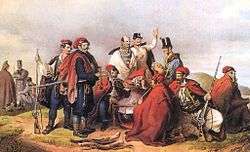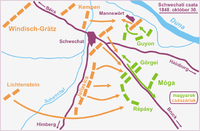Battle of Schwechat
| Battle of Schwechat | |||||||
|---|---|---|---|---|---|---|---|
| Part of the Hungarian Revolution of 1848 | |||||||
 "The Battle of Schwechat" by Anton Ziegler, 1850 | |||||||
| |||||||
| Belligerents | |||||||
|
|
| ||||||
| Commanders and leaders | |||||||
|
|
| ||||||
| Strength | |||||||
|
c. 30,000 men 70 cannon |
80,000 men 210 cannon | ||||||
The Battle of Schwechat was a battle in the Hungarian Revolution of 1848, fought on 30 October 1848 between the revolutionary Hungarian Army against the army of the Austrian Empire, in Schwechat, near Vienna. This was the last battle of 1848 in the Transdanubian campaign. The Hungarian Army was under the command of János Móga and the Austrian Army was under the command of Alfred I, Prince of Windisch-Grätz.
Pretext
Jelačić’s retreat
Some days after the Battle of Pákozd János Móga and his Hungarian army pursued Croatian Ban Josip Jelačić. Jelačić and his Croat army retreated towards Vienna for two reasons: first, he knew he would get some support from Vienna; second, he could not retreat, because militiamen and territorials were occupying South Transdanubia. Neither could they retreat in the direction of the fortress of Komárom, because it switched allegiance to the Constitution of Hungary, an allegiance that lasted until the end of the revolution. On 4 October Jelačić arrived at Moson. He planned to wait for reinforcements and then attack the Hungarian Army.
During Jelačić’s retreat there was major political upheaval. The Emperor had not heard of the Hungarian victory at the Battle of Pákozd, but he received the news that Ferenc Lamberg had been killed. The Emperor thought it was time to attack the Constitution of Hungary in public. The Emperor refused to recognise the Batthyány Government and ordered the Hungarian Parliament be dissolved. Furthermore, he appointed Jelačić as the civic and military regent of Hungary.
Jelačić's main supporter, the Austrian Secretary of War Theodor Franz, Count Baillet von Latour, sent troops to help him; however, von Latour was unaware that Vienna had very few soldiers. This was a mistake, and he paid for the error with his life. Those in Vienna sympathetic to the Hungarian cause started a rebellion on 6 October. The Emperor and his subjects escaped to Olmütz but Latour was lynched by rebels. After Jelačić heard of the rebellion, he left Hungary towards Vienna. On 10 October the Hungarian Army reached the Austrian border and stopped pursuing Jelačić.
The delayed Hungarian attack
The delayed attack by the Hungarian army is controversial among those studying Hungarian military history. When the rebellion started in Vienna, everyone took for granted that the Hungarians would come to the rebels' aid. Had they done so, it could have changed the course of the revolution. More so, had they done so and won, the Habsburg Empire might have collapsed.

The Hungarian army had good reason not cross the Austrian border. After the Battle of Pákozd, Jelačić’s army was stronger than ever. Jelačić sent the inexperienced Croatians back to Croatia under the command of Kuzman Todorović because he knew that troops were en route from Vienna. As a result, the Hungarian army had to fight the more experienced, stronger Austrian army. This decision led to some infighting among the leaders of the Hungarian army. János Móga decided to follow the orders of the Hungarian National Defence Commission not to attack. But the members of the Commission varied in their views about crossing the Austrian border. The Left wanted to help the rebels in Vienna, but the Right objected to this idea. From the start Lajos Kossuth said that the Hungarians were not rebels, but were only protecting their own country. Later, he changed his mind, and on 18 October he visited the Hungarian army to tell them his views.
Battle



The start of the battle was promising for the Hungarian army. The right flank, under the command of Richard Debaufre Guyon, took control of Manswörth after twenty minutes' fighting. But the battle was less easily won in the centre, the left flank (under the command of Colonel Mihály Répásy) arrived too late, so Guyon's success changed the formation of the Hungarian line: it became one arm of a pincer movement. This was unfortunate because the Austrian army could get into the centre very easily, so Móga gave an order to Artúr Görgey to recall his central troops.
Jelačić realised that the centre was defenceless and ordered lieutenant-general Lichtenstein's cavalry to move towards the central Hungarian army. At the same time major-general Karl Zeisberg attacked Görgey. Most of Görgey's legion lacked experience, were afraid of gunfire and deserted. The Hungarian artillery – after a short retreat – started to attack the Austrians, who were advancing towards the central Hungarian army.
Fortunately for the Hungarians, although Répásy delayed he still arrived before the Austrian army started to attack the central Hungarian army. His presence persuaded Lichtenstein not to start fighting, so the Austrian army could not encircle the central Hungarian army. Windisch-Grätz also made a strategic error by not retreating to Vienna, so he was in no position to pursue the Hungarian army.
Aftermath
The main aim of the Austrian army's leaders was to prevent the rebels in Vienna and the Hungarian army banding together. In that respect, Windisch-Grätz won the battle as he successfully attacked the Hungarians and the rebels capitulated. But the defeat was not decisive as the Hungarian army kept its strength until they reached the Austrian border.
The battle showed that inexperienced men were not good enough to fight against the Emperor's army. It became clear that the Hungarian army needed brave leaders too. After this battle, only the loyal and brave leaders got higher positions in the Hungarian army.
Sources
- Hermann, Róbert (2004), Az 1848–1849-es szabadságharc nagy csatái ("Great Battles of the Hungarian Revolution of 1848 – 1849") (in Hungarian), Zrínyi, ISBN 963-327-367-6
- Hermann, Róbert (2008), "Az eldöntő döntetlen. A schwechati csata 1848. október 30-án ("The Semi-final is Drawn. The Battle of Schwechat, 30 October 1848")", A Drávától a Lajtáig. Tanulmányok az 1848. nyári és őszi dunántúli hadi események történetéhez ("From the River Dráva to the River Lajta. Studies on the summer and autumn military events of 1848") (in Hungarian), Balassi, ISBN 978-963-506-758-9
- Ervin Liptai, ed. (1985), Magyarország hadtörténete két kötetben ("Hungarian Military History in Two Volumes") (in Hungarian), Zrínyi Katonai (Zrínyi Military), ISBN 963-326-337-9
- Pusztaszeri, László (1984), Görgey Artúr a szabadságharcban ("Artúr Görgey in the Hungarian Revolution of 1848") (in Hungarian), Magvető, ISBN 963-14-0194-4
- Kedves, Gyula; Zachar, József; Zachar, Péter Krisztián (1999), 1848/49-ről százötven év távlatából ("1848-49 Seen 150 years Thence") (in Hungarian), Siklósi Vár és Múzeumbaráti Kör (Friends of Siklós Castle and Museum), ISBN 963-03-9298-4
| Wikimedia Commons has media related to Battle of Schwechat. |